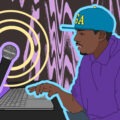It’s a technology of perfection that’s been called both the electric guitar of our age and one of history’s worst inventions. Auto-Tune, and its underlying pitch-correction technology, have forever changed the music industry. Initially meant to help recording engineers and artists reduce the time needed to get the perfect take, pitch correction software has become a versatile tool both revered by some for its creative uses and despised by others for its overuse and ability to replace* actual talent. Let’s look at both sides of the story and introduce some of the pitch correction software currently being used in the music industry.
*Pitch correction software is not a replacement for actual talent.
Problems with quality control
Before the invention of multitrack recording, captures that weren’t perfect would need to be entirely re-recorded. This was a highly inefficient and expensive process. After the development of multitrack recording, overdubbing could help mask select subpar samples, meaning mistakes could be fixed without having to redo everything. This still required a high level of skill and patience, however, with dozens and sometimes hundreds of takes needed to get the perfect part and an editor having to physically cut up and splice tape to create the best possible track.
The digital solution
The music industry hoped to create a technology that would take audio that was almost perfect and make it perfect. This would happen with the H910 Harmonizer, the world’s first commercially available digital effects processor, which drastically expanded what could be achieved with music editing.
Developed by Eventide in 1974, the device could change the pitch of a sound in real-time without changing its duration. It could change pitch up to one octave higher or lower, delay playback up to 112.5ms, and add feedback. Jimmy Page, Frank Zappa, David Bowie, Tony Platt, Eddie Van Halen, and Steve Winwood all used the H910 in various capacities. The H910’s successor, the Eventide Harmonizer H949, was also popular, boasting the world’s first ‘de-glitched’ pitch shifting. For those interested, Eventide released a video discussing how different producers used the H910 when it first came out.
Modern pitch correction software
Although various samplers like the Fairlight CMI permitted pitch shifting, pitch correction as we know it today would only really start to emerge in the 90s. At this time, mathematician Dr. Andy Hildebrand took sonic techniques he’d originally developed to help Exxon find oil fields and created the now-legendary software brand Auto-Tune. Released to the public in 1997, the software could be purchased as a standalone product or convenient plug-in for the Pro Tools DAW.
Impact on the industry
Auto-Tune spread like wildfire in the late 90s electronic dance music scene. Within a year, it was already being exploited for its creative potential by artists like Cher (“Believe”) and Eiffel 65 (“Blue”), both early examples of what would later be known as the T-Pain Effect.
While engineers would rejoice over the time- and money-saving properties of pitch correction, and many artists would find creative and experimental uses for it over the coming decades, there would also be many who denounced the technology.
In 2009, Death Cab for Cutie wore blue ribbons to the Grammys to raise awareness for “Auto-Tuner abuse.” Jay-Z had already released an Auto-Tune diss track that year. The authenticity and talent (or lack thereof) of a corrected performance are typical points of contention, as are fears that ‘natural’ artistic talent will be erased in favour of slicker studio productions.
Although a certain amount of healthy skepticism is to be expected of any new technology, the continued use of pitch shifting to save time in the studio and contribute to experimental soundscapes in massively popular music projects indicates that it is most definitely here to stay. And while the T-Pain effect may one day lose its novelty, the impact of pitch correction software on the professional sound engineering workflow is here to stay.
What makes the ‘tune’ in Auto-Tune?
Tools like Auto-Tune, Melodyne, OVox, and Revoice Pro fix an off sample by tweaking it to match its closest note frequency. The programs listen for different preset note frequencies (like 440 Hz for the A above middle C), and the engineer can then decide when and how dramatically the off sample should be shifted to these presets.
A gradual shift will sound more natural, whereas a rapid and continual shift will sound more robotic or unnatural. The reason these software edits can work for subtle corrections versus the ‘chipmunk’ effect of a sped-up tape is due to how they digitally sample musical information. It’s also good to note that although vocoders and talk boxes create sounds that seem related, they work with different mechanisms than digital pitch correction.
A brief history of pitch correction in action
Although it wasn’t until electronic interventions that we would see pitch correction as we know it, producers working with multitrack recording were able to develop some clever editing tricks. “Strawberry Fields Forever” was actually built from two spliced takes that had been recorded at different tempos, one in B flat minor and 90 bpm, the other C major and 108 bpm. Increasing the speed of the 90 bpm take also increased its pitch, making it match the faster version. Can you hear the cut happen at 1:00?
The H910 Harmonizer helped David Bowie and AC/DC achieve unique snare effects on “Breaking Glass” and “Back in Black”, respectively.
After the invention of Auto-Tune in 1997, Cher’s “Believe” skyrocketed digital pitch correction to the public forefront in 1998.
Radiohead would apply digital pitch correction to the tracks “Packt Like Sardines In a Crushd Tin Box” and “Pulk/Pull Revolving Doors” on their 2001 album Amnesiac.
A list of pitch-corrected music wouldn’t be complete without mentioning T-Pain. His tracks pushed the warbly robotic sound of extreme digital pitch correction into both the ears of the mainstream and experimental music scenes alike.
808s & Heartbreak by Kanye West is a notable example of digital pitch correction being used throughout a project. Tracks like “Welcome to Heartbreak” convey a coldness enhanced by select digital adjustments. He’d return to the technology throughout his career with tracks like “Blood on the Leaves” on Yeezus and “Wolves” on The Life of Pablo.
Bon Iver has also embraced digital pitch correction as a unique and popular staple of their sound.
What’s next for digital pitch correction?
An increasing interest in incorporating Artificial Intelligence (AI) into music production has brought some exciting developments in how music can be edited. Trained neural networks can learn to look for certain markers and manipulate a track based on desired parameters. There’s been AI developed that can clone voices, separate vocals from backing instrumentals, and of course, pitch correct.
Additional resources
Eventide has detailed specifications available for both their H910 Harmonizer, and their H949 Harmonizer. Valhalla DSP have also explained in greater detail how the H949 achieved its de-glitching abilities.
A scientific explanation of how digital pitch correction works is available at physics.org. A similar explanation can also be seen in an episode of Nova Science Now with the inventor of Auto-Tune, Dr. Andy Hildebrand. For an idea of what might be possible in the future, the paper “Deep Autotuner: A Data-Driven Approach to Natural-Sounding Pitch Correction for Singing Voice in Karaoke Performances” speculates how AI could be used for unsupervised pitch correction.





















